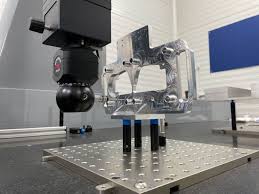The Art of High Precision Machining Parts
High precision machining is a sophisticated process that involves the creation of intricate parts with incredibly tight tolerances. This precision engineering technique is essential in industries such as aerospace, automotive, and medical, where even the smallest deviation can have significant consequences.
One of the key aspects of high precision machining is the use of advanced machinery and cutting-edge technology. Computer Numerical Control (CNC) machines play a crucial role in achieving the accuracy and consistency required for these components. These machines are capable of performing complex operations with pinpoint accuracy, ensuring that each part meets the exact specifications.
Materials used in high precision machining vary depending on the application but often include metals such as aluminium, stainless steel, and titanium. These materials are known for their strength, durability, and ability to withstand challenging environments.
The process of high precision machining involves multiple steps, including design, programming, tool selection, cutting, and quality control. Skilled machinists with expertise in programming and operating CNC machines are essential to ensure that each part is manufactured to perfection.
Quality control is a critical aspect of high precision machining. Advanced measuring instruments such as Coordinate Measuring Machines (CMM) are used to verify the accuracy of each part. Any deviations from the specified dimensions are carefully identified and corrected to meet the required standards.
In conclusion, high precision machining is a precise art that requires skill, expertise, and attention to detail. By utilising advanced technology and rigorous quality control measures, manufacturers can produce components that meet the highest standards of accuracy and reliability.
Top 5 Tips for Achieving High Precision in Machining Parts
- Use high-quality cutting tools for better precision.
- Maintain a clean and controlled working environment to minimize errors.
- Ensure proper calibration of machinery for accurate measurements.
- Implement regular quality checks during the machining process.
- Follow manufacturer’s guidelines and recommended parameters for optimal results.
Use high-quality cutting tools for better precision.
When it comes to high precision machining parts, a crucial tip to enhance accuracy is to use high-quality cutting tools. The quality of the cutting tools directly impacts the precision and consistency of the machining process. By investing in top-notch cutting tools, manufacturers can achieve finer finishes, tighter tolerances, and overall improved part quality. High-quality cutting tools are designed to withstand the demands of precision machining, ensuring reliable performance and superior results.
Maintain a clean and controlled working environment to minimize errors.
To ensure the highest level of precision in machining parts, it is crucial to maintain a clean and controlled working environment. By keeping the workspace free from debris, dust, and other contaminants, the risk of errors and imperfections in the machining process is significantly reduced. A clean environment helps to prevent interference with the machinery and ensures that each component is produced with utmost accuracy and consistency. Implementing strict cleanliness protocols and maintaining a controlled atmosphere are essential practices in achieving flawless high precision machining results.
Ensure proper calibration of machinery for accurate measurements.
To achieve impeccable results in high precision machining, it is crucial to ensure the proper calibration of machinery for accurate measurements. Precision engineering relies heavily on the accuracy of measurements, and any deviations can lead to subpar outcomes. By meticulously calibrating the machinery used in the manufacturing process, manufacturers can maintain consistency and precision in producing high-quality components that meet stringent specifications. Calibration is a fundamental step that guarantees the reliability of measurements and ultimately contributes to the overall success of high precision machining operations.
Implement regular quality checks during the machining process.
To ensure the production of high-quality precision machining parts, it is crucial to implement regular quality checks throughout the machining process. By conducting frequent inspections and measurements at key stages of production, manufacturers can identify any deviations from the desired specifications early on. This proactive approach allows for timely adjustments to be made, ensuring that each part meets the required standards of accuracy and precision. Regular quality checks not only help maintain consistency and reliability but also contribute to the overall efficiency of the manufacturing process.
Follow manufacturer’s guidelines and recommended parameters for optimal results.
To achieve the best results in high precision machining, it is crucial to follow the manufacturer’s guidelines and recommended parameters diligently. These guidelines provide essential information on tool selection, cutting speeds, feeds, and other critical factors that can significantly impact the quality and accuracy of the machined parts. By adhering to these recommendations, manufacturers can ensure optimal performance of their machinery and produce components that meet the stringent requirements of high precision machining.

